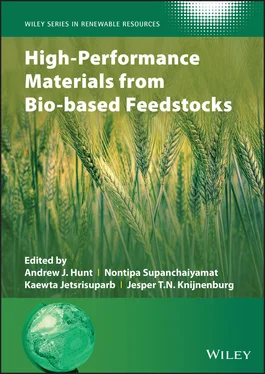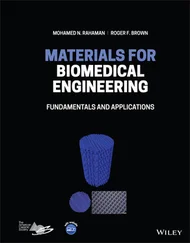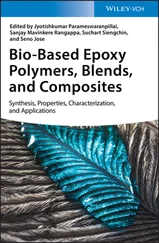High-Performance Materials from Bio-based Feedstocks
Здесь есть возможность читать онлайн «High-Performance Materials from Bio-based Feedstocks» — ознакомительный отрывок электронной книги совершенно бесплатно, а после прочтения отрывка купить полную версию. В некоторых случаях можно слушать аудио, скачать через торрент в формате fb2 и присутствует краткое содержание. Жанр: unrecognised, на английском языке. Описание произведения, (предисловие) а так же отзывы посетителей доступны на портале библиотеки ЛибКат.
- Название:High-Performance Materials from Bio-based Feedstocks
- Автор:
- Жанр:
- Год:неизвестен
- ISBN:нет данных
- Рейтинг книги:5 / 5. Голосов: 1
-
Избранное:Добавить в избранное
- Отзывы:
-
Ваша оценка:
- 100
- 1
- 2
- 3
- 4
- 5
High-Performance Materials from Bio-based Feedstocks: краткое содержание, описание и аннотация
Предлагаем к чтению аннотацию, описание, краткое содержание или предисловие (зависит от того, что написал сам автор книги «High-Performance Materials from Bio-based Feedstocks»). Если вы не нашли необходимую информацию о книге — напишите в комментариях, мы постараемся отыскать её.
High-Performance Materials from Bio-based Feedstocks
The latest advancements in the production, properties, and performance of bio-based feedstock materials
www.wiley.com/go/rrs High-Performance Materials from Bio-based Feedstocks
High-Performance Materials from Bio-based Feedstocks
High-Performance Materials from Bio-based Feedstocks — читать онлайн ознакомительный отрывок
Ниже представлен текст книги, разбитый по страницам. Система сохранения места последней прочитанной страницы, позволяет с удобством читать онлайн бесплатно книгу «High-Performance Materials from Bio-based Feedstocks», без необходимости каждый раз заново искать на чём Вы остановились. Поставьте закладку, и сможете в любой момент перейти на страницу, на которой закончили чтение.
Интервал:
Закладка:
The hydrophilic nature of many polysaccharides presents a poor mechanical strength, which is a major hurdle for their widespread use. For this reason, polysaccharides are often blended with other polymers and/or chemically modified to improve their properties. In addition, inorganic additives can also play a key role to enhance materials properties from boosting strength to improving oxygen barrier and antibacterial properties. For example, esterification, etherification, acetylation, hydroxylation, and oxidation of starch, as well as the blending of starch with other biodegradable polymers can improve its physical and mechanical properties for food‐packaging applications ( Chapter 15). Similarly, the substitution of hydrogen by alkyl groups to form cellulose ethers including ethyl cellulose (EC) and carboxymethyl cellulose (CMC) increases the hydrophobicity of cellulose. The addition of CMC into food packaging can improve mechanical, thermal, and barrier properties ( Chapter 15). Although biopolymers account for less than 1% of the total plastic production [9], there is a strong growth potential toward their wider application driven by the circular economy trend. Novel biopolymers with improved properties and new functionalities for various applications such as packaging films and coatings as well as textile applications have been developed for commercialization and are reviewed in Chapter 15with the emphasis on the packaging.
Similar modifications to the hydrophobicity of biopolymers have been used in coating materials in controlled release fertilizers. In coated fertilizers, the hydrophilicity of native biopolymers results in the buildup of osmotic pressure inside the fertilizer beads. This causes the coatings to break prematurely, resulting in burst release of the nutrients. Naturally obtained biopolymers are thus not ideal fertilizer‐coating materials owing to the lack of hydrophobicity and modifications are necessary to help control the nutrient release. By replacing hydroxy groups with ester groups, cellulose acetate (CA), which is a common cellulose derivative, can be prepared. The presence of ester introduces its pH sensitivity property to the materials and can be beneficial for applications not only in slow‐release fertilizers ( Chapter 16) but also in drug delivery ( Chapter 8).
In other applications, the hydrophilicity and swelling behavior of biopolymers are used as an advantage. A different class of fertilizers is that of hydrogel‐based fertilizers, which absorb and retain high amounts of water. Hydrogel composites with plant nutrients embedded in their network structure using alginate or chitosan have been developed to reduce the frequency of irrigation as well as controlling the rate of nutrient release ( Chapter 16). Hydrogels also find applications in targeted drug delivery. The biocompatibility, biodegradability, and non‐toxicity as well as high affinity for water make biopolymers like alginate, hyaluronic acid, pectin, and carrageenan attractive in controlled release and targeted drug delivery systems for HIV prophylaxis ( Chapter 8). Alginate microparticles and films have also been used for anti‐HIV drug delivery due to their excellent biocompatibility and biodegradability ( Chapter 8), and alginate has been blended with other polymers to adjust the hydrophobicity of polyelectrolyte films for food‐packaging applications ( Chapter 15).
An interesting group of oligosaccharides with both hydrophilic and hydrophobic properties is that of cyclodextrins. The truncated cone structure of these circular oligosaccharides exhibits a hydrophobic inner cavity, while the upper and lower rims are hydrophilic. These unique properties enable cyclodextrins to contain hydrophobic molecules, but the high costs limit the applicability in foods ( Chapter 14). Cyclodextrins can also be used to form metal–organic frameworks (MOFs) that have been investigated for a variety of potential applications including molecular separations, drug delivery, and biomedicine. Organic ligands are the main factors that determine if an MOF is bio‐based, but the sustainability and safety of the metal ions should also be considered ( Chapter 12).
Biodegradability is preferred in some applications such as packaging and fertilizers. The biodegradability needs to be tuned, however, to meet the desired product specifications. For example, in fertilizers, polysaccharide‐based coatings based on, e.g. starch or cellulose, are too biodegradable, leading to premature nutrient release into the soil. To reduce the rate of degradation in soil and extend its service time, the biopolymer can be grafted with rubber or a different polymer with a lower biodegradability and higher hydrophobicity ( Chapter 16). In food packaging, many packaging materials are based on blends of biodegradable polysaccharides such as starch, cellulose, and chitosan. In addition, cellulose nanocrystals, nanofibers, and bacterial cellulose have been used as biodegradable reinforcing fillers in various packaging films ( Chapter 15).
Due to their biological nature, the biocompatibility of polysaccharides can be taken advantage of in applications where the polymer requires intimate contact with cells. For example, mucoadhesive films based on derivatives of cellulose, alginate, or chitosan can provide sustained release of several antiretroviral agents ( Chapter 8). Moreover, biomaterials are critical to success in tissue engineering, act as a scaffold for tissue and cells to grow on. Such scaffolds can be derived from protein or carbohydrate biopolymers, including silk, collagen, fibrin, chitosan, alginate, and agarose. Biocompatibility and the ability to contribute to biological functions with the cells are necessary properties. Chapter 11highlights bio‐based feedstock that can be used in scaffold manufacturing for tissue engineering.
Carbohydrate‐based materials play an essential role in cellular recognition processes. Carbohydrate‐protein interactions can be probed by synthetic glycomaterials to diagnose viral and bacterial infections. In Chapter 10, bio‐based glycomaterials and carbohydrate‐functionalized materials are discussed including their application in drug/gene delivery, wound healing, biorecognition, and sensing.
Chitosan and chitin/glucan complexes have been used in a wide range of applications such as anticancer, antibacterial, antioxidant as well as gene delivery due to their unique biochemical properties ( Chapter 9). The major limitation of these biopolymers is their insolubility in water and, as such, steps have been taken to improve their solubility by various modification methods. Other applications of chitosan include fertilizers ( Chapter 16) and antibacterial food packaging ( Chapter 15). For food‐packaging applications, chitosan is limited by its low mechanical strength, rigid structure, and low thermal stability, which can be overcome by blending chitosan with other (bio)polymers ( Chapter 15).
Due to their safety and biocompatibility, polysaccharide‐based materials find applications in the food industry as emulsion stabilizers. Starch modified with octenyl succinic anhydride (OSA) generates an amphiphilic character of the starch, making it an effective stabilizer of oil‐in‐water emulsions. Gums such as gum acacia, gum tragacanth, xanthan gum, and guar gum are used as surfactants to stabilize emulsions and liposomes in the food industry, as well as the formation of coacervates. Additionally, cellulose nanocrystals find applications in food applications in the stabilization of Pickering emulsions ( Chapter 14).
Polysaccharides have a high abundance of functional groups, e.g. hydroxyl groups of cellulose, amine of chitosan, and carboxylic acid of alginate. These functional groups have a good affinity for complexation of metal ions through mechanisms such as reduction, chelation, and complexation. The polysaccharides alone are poor sorbents due to their low stability and need to be improved by chemical (e.g. introduction of other functional groups) as well as physical modification (e.g. forming composites with other polymers as well as inorganic materials). The use of bio‐based composites for the recovery of precious and heavy metals is discussed in detail in Chapter 7.
Читать дальшеИнтервал:
Закладка:
Похожие книги на «High-Performance Materials from Bio-based Feedstocks»
Представляем Вашему вниманию похожие книги на «High-Performance Materials from Bio-based Feedstocks» списком для выбора. Мы отобрали схожую по названию и смыслу литературу в надежде предоставить читателям больше вариантов отыскать новые, интересные, ещё непрочитанные произведения.
Обсуждение, отзывы о книге «High-Performance Materials from Bio-based Feedstocks» и просто собственные мнения читателей. Оставьте ваши комментарии, напишите, что Вы думаете о произведении, его смысле или главных героях. Укажите что конкретно понравилось, а что нет, и почему Вы так считаете.












